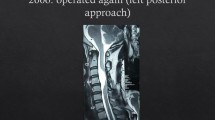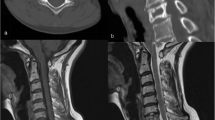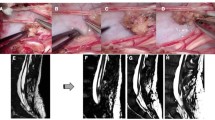Abstract
Fibrous bands are one of the causes of tethered cord syndrome and these can be located on the dorsal or more rarely, ventral aspect of the dura mater. We report a case of dorsal and ventral tethering bands in the same patient found at surgery for tethered cord syndrome. Such fibrous bands restrict normal movement of the spinal cord and lead to a variety of neurological symptoms. To our knowledge, we report the first case of dorsal and ventral tethering bands of the spinal cord in the same patient. This case report aims to increase awareness of such anatomical variations and emphasize the importance of meticulous surgical dissection in order to identify such bands.



Similar content being viewed by others
Explore related subjects
Discover the latest articles and news from researchers in related subjects, suggested using machine learning.References
Kaffenberger DA, Heinz ER, Oakes JW, Boyko O (1992) Meningocoele manqué: radiologic findings with clinical correlation. Am J Neuroradiol 13:1083–1088
Kriss VM, Kriss TC, Warf BC (1996) Dorsal tethering bands of the meningocele manque: sonographic findings. Am J Roentgenol 167:1293–1294. https://doi.org/10.2214/ajr.167.5.8911198
Lassman LP, James CM (1977) Meningocoele manqué. Childs Brain 3:1–11
Pang D (2001) Ventral tethering in split cord malformation. Neurosurg Focus 10:1–11. https://doi.org/10.3171/foc.2001.10.1.7
Solmaz I, Izci Y, Albayrak B, Cetinalp E, Kural C, Sengul G, Gocmez C, Pusat S, Tuzun Y (2011) Tethered cord syndrome in childhood: special emphasis on the surgical technique and review of the literature with our experience. Turk Neurosurg 21:516–521. https://doi.org/10.5137/1019-5149.JTN.4394-11.1
Venkataramana NK (2011) Spinal dysraphism. J Pediatr Neurosci 6:31–40. https://doi.org/10.4103/1817-1745.85707
Author information
Authors and Affiliations
Corresponding author
Ethics declarations
Conflict of interest
On behalf of all authors, the corresponding author states that there is no conflict of interest.
Rights and permissions
About this article
Cite this article
Eid, S., Iwanaga, J., Loukas, M. et al. Ventral and dorsal tethering bands of the spinal cord in the same patient: a case report. Childs Nerv Syst 35, 389–391 (2019). https://doi.org/10.1007/s00381-018-3993-5
Received:
Accepted:
Published:
Issue Date:
DOI: https://doi.org/10.1007/s00381-018-3993-5




